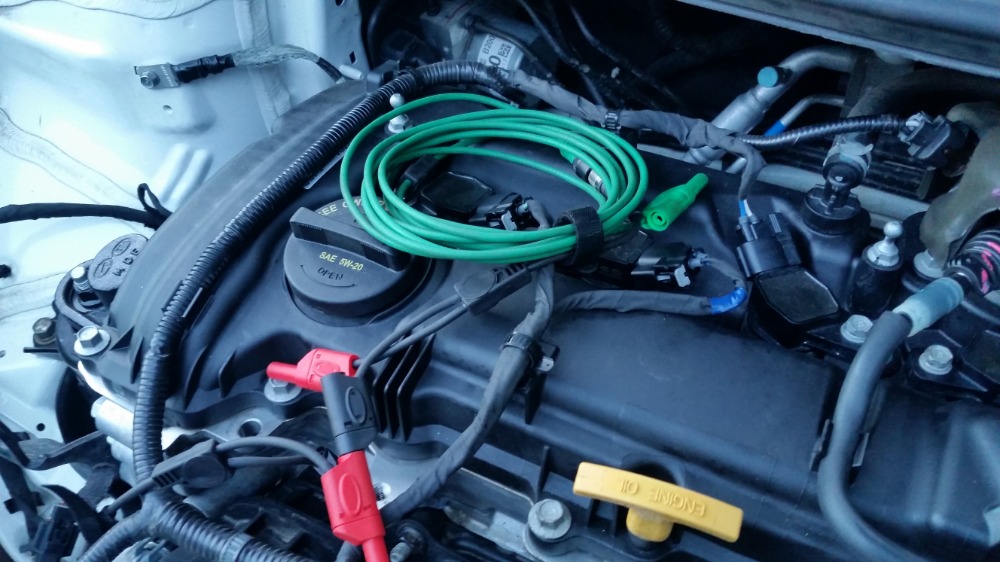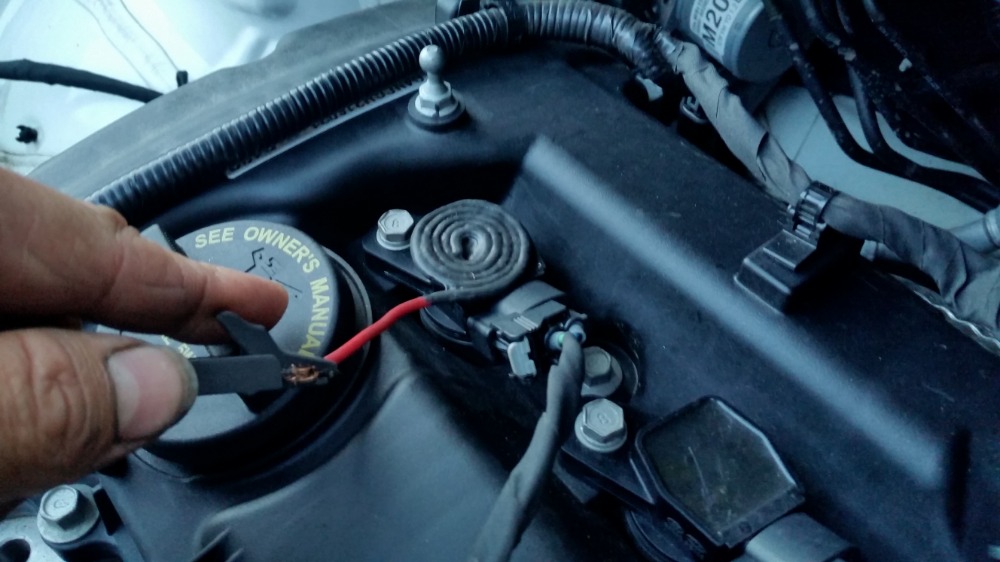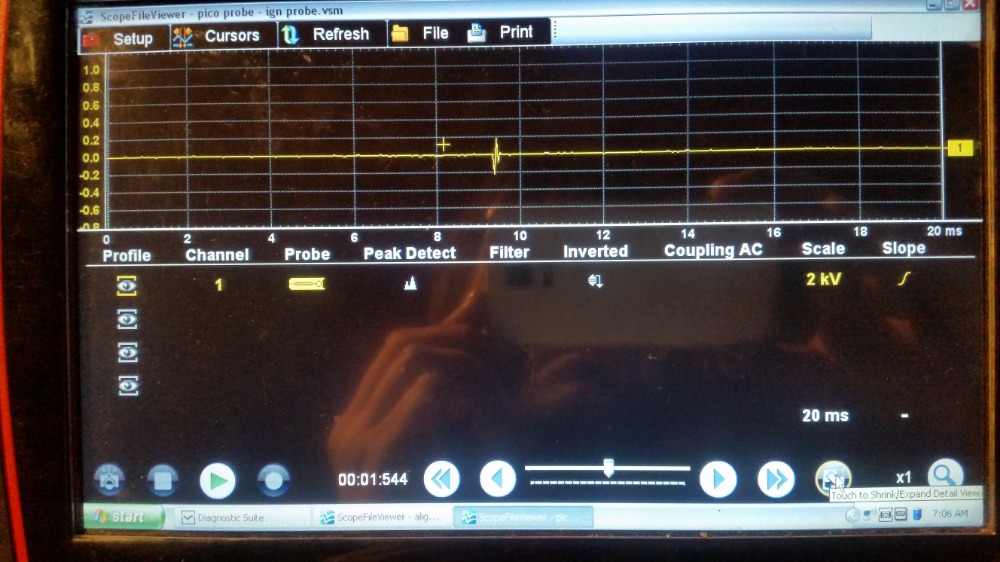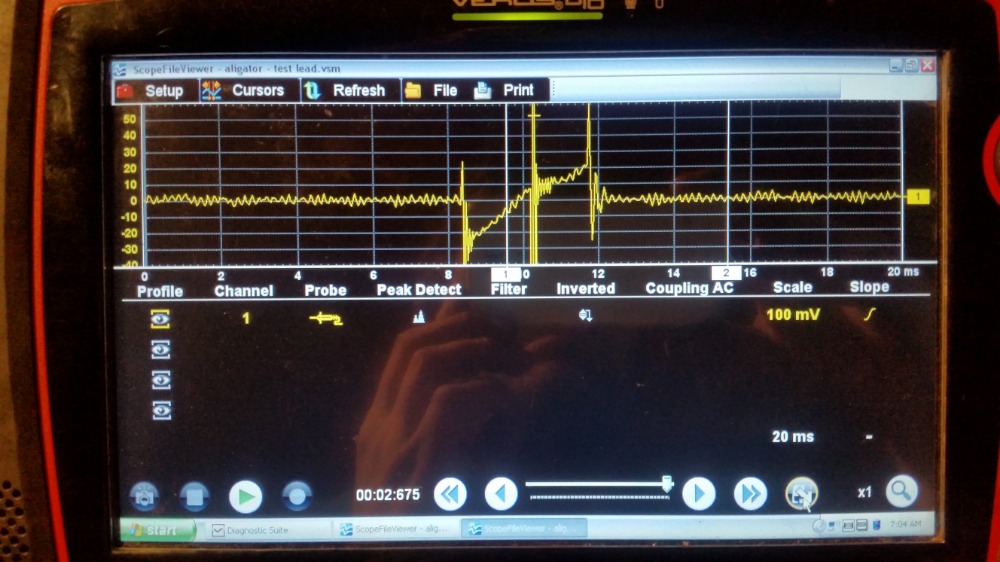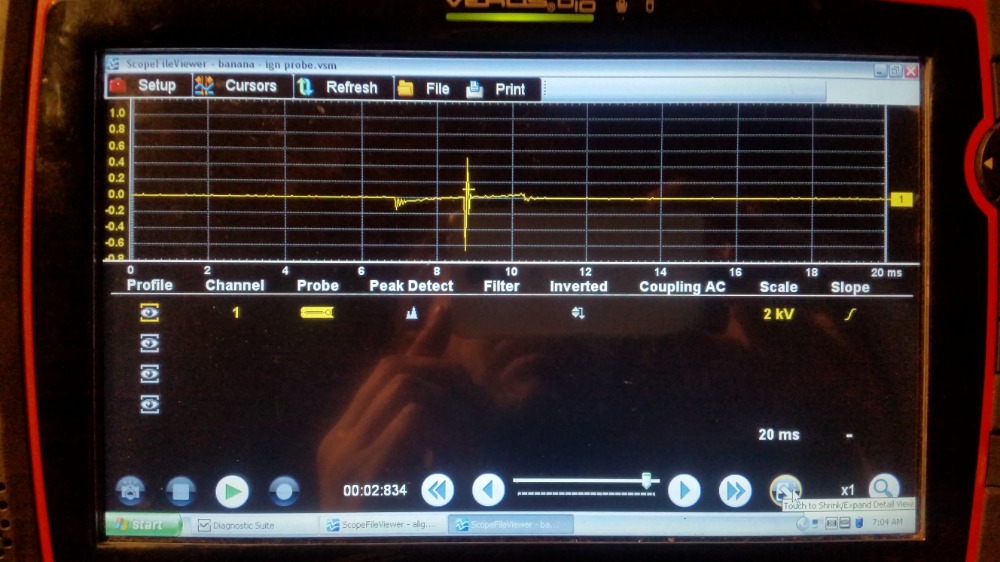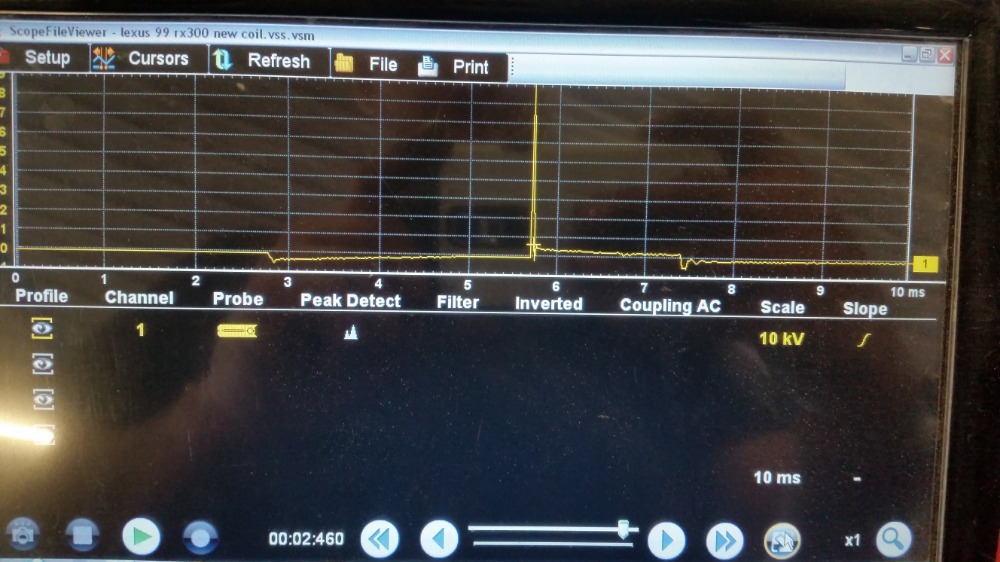*** Restricting New Posts to SD Premium Members ONLY *** (09 May 2025)
Just made a new account? Can't post? Click above.
Ignition Probe Discussions \ Tests & Debates - Do YOU need to buy one?
- graywave
-
 Topic Author
Topic Author
- Offline
- Elite Member
-

- Adv. Diagnostics New Hampshire
- Posts: 302
- Thank you received: 80
I have been having a hard time with ignition probes and decided to make a side by side comparison.
Vehicle: 2017 Kia Forte5 2.0L - Cyl #1 Coil. (All coils presented same waveforms.)
Here are the contestants and how they were used.
Pico Probe. Cost: $149 + Shipping
Wyze Probe 15". Cost: $139 + Shipping
Alligator Clamp. Cost: You probably have one
Banana Plug. Cost: You probably have one
Test Lead Coiled - Using shielding as the inductor - Added a Current Ramp to the Waveform to pin point Coil #1
DIY Probe. Coil of Wire. Cost: Pennies
Confirm what it's not, and fix what it is!
Please Log in or Create an account to join the conversation.
- graywave
-
 Topic Author
Topic Author
- Offline
- Elite Member
-

- Adv. Diagnostics New Hampshire
- Posts: 302
- Thank you received: 80
Pico Probe. Scope Probe Setting: Test Lead
Wyze Probe. Scope Probe Setting: Ignition
Wyze Probe. Scope Probe Setting: Test Lead
Alligator Clamp. Scope Probe Setting: Ignition
Alligator Clamp. Scope Probe Setting: Test Lead
Confirm what it's not, and fix what it is!
Please Log in or Create an account to join the conversation.
- graywave
-
 Topic Author
Topic Author
- Offline
- Elite Member
-

- Adv. Diagnostics New Hampshire
- Posts: 302
- Thank you received: 80
Banana Plug. Scope Probe Setting: Test Lead
Test Lead Coiled. Scope Probe Setting: Ignition
Test Lead Coiled. Scope Probe Setting: Test Lead (Added Current Ramp for #1 Coil)
DIY Probe. Scope Probe Setting: Ignition
DIY Probe. Scope Probe Setting: Test Lead
Confirm what it's not, and fix what it is!
Please Log in or Create an account to join the conversation.
- graywave
-
 Topic Author
Topic Author
- Offline
- Elite Member
-

- Adv. Diagnostics New Hampshire
- Posts: 302
- Thank you received: 80
Anyone know more about building induction pick up coils?
Confirm what it's not, and fix what it is!
Please Log in or Create an account to join the conversation.
- Tyler
-

- Offline
- Moderator
-

- Full time HACK since 2012
- Posts: 6053
- Thank you received: 1523
The quality of waveform you get out of the 'impromptu' probes is blowing my mind. Is the coil of wire thing just wire and shrink wrap, or is it more intricate?
Alligator Clamp. Cost: You probably have one
Hoooooold up a second here. You think everyone reading this thread has alligator clamps just lying around?!
Please Log in or Create an account to join the conversation.
- graywave
-
 Topic Author
Topic Author
- Offline
- Elite Member
-

- Adv. Diagnostics New Hampshire
- Posts: 302
- Thank you received: 80
Tyler wrote: No, but you can bet I'm interested now! :woohoo: Excellent comparison, sir.
The quality of waveform you get out of the 'impromptu' probes is blowing my mind. Is the coil of wire thing just wire and shrink wrap, or is it more intricate?
Just plain wire. I believe it was 16 AWG wire. I tightly wrapped it in a circle using super glue to hold it together and used Liquid tape, about 3-4 coats to cover it up. I also tried 18 awg wire with more wraps and two layers of wraps but didn't make a difference, if anything it made it less effective. I think the second layer (all one strand of wire) might have had a negative effect.
Tyler wrote:
Alligator Clamp. Cost: You probably have one
Hoooooold up a second here. You think everyone reading this thread has alligator clamps just lying around?!
HAHAHA Well if you don't I feel sorry for you!! O wait... No I don't... :evil:
Confirm what it's not, and fix what it is!
Please Log in or Create an account to join the conversation.
- graywave
-
 Topic Author
Topic Author
- Offline
- Elite Member
-

- Adv. Diagnostics New Hampshire
- Posts: 302
- Thank you received: 80
So using a coil of wire might work on some coils, but may over power your scales on your scope on other coils. I am thinking that 1x 20:1 attenuator may not be enough to bring the waveform within your voltage scale on some coils or wires. I have 4x, so maybe stacking them together. That might be where the professional probes come in. I will be keeping the pico probe for this reason. I also like that there is no metal exposed so a spark shouldn't jump to the probe unlike the wyze probe.
Edit: I don't know if there is a calibration difference between Pico and Verus in terms of scaling for the attenuation. AESWave tells me I should be using the "test lead voltage scale" with peak detect on and possibly inverted to use a pico or wyze probe.
Confirm what it's not, and fix what it is!
Please Log in or Create an account to join the conversation.
- graywave
-
 Topic Author
Topic Author
- Offline
- Elite Member
-

- Adv. Diagnostics New Hampshire
- Posts: 302
- Thank you received: 80
I used my DIY Probe (coiled wire) and it worked perfectly. I have snap shots of it.
Confirm what it's not, and fix what it is!
Please Log in or Create an account to join the conversation.
- graywave
-
 Topic Author
Topic Author
- Offline
- Elite Member
-

- Adv. Diagnostics New Hampshire
- Posts: 302
- Thank you received: 80
Bad coil (no spark at all though i see a biy of a firing line so must be arcing internally? All the hash I am see I think would tell me high resistance.
For some reason it saved off the screen
Confirm what it's not, and fix what it is!
Please Log in or Create an account to join the conversation.
- Tyler
-

- Offline
- Moderator
-

- Full time HACK since 2012
- Posts: 6053
- Thank you received: 1523
First up is an '09 Escape with the 2.5L. The attenuation factor that graywave was talking about is VERY evident here. Here's a shot of the alligator clip on the top of the coil:
I don't have my Pico TA204 on hand to compare to, but I can say this waveform is very close to what it'd generate. Note this is on a 50kV scale, the highest the Modis (and probably the Verus, too) has in the Ignition Probe mode.
Then I went for the bottom of the coil:
Whoa. :blink: The Ignition Probe mode just doesn't know what to do any more. You'd have to go over to a regular voltage scale to see anything useful. Still, this begs the question: Why did I buy the TA204? :dry: :lol:
The attenuation thing is super evident in this video:
drive.google.com/file/d/1uOmGDT-h00PBXGc...08T/view?usp=sharing
Then I had to try it out on the Scion. I've never had luck with secondary waveforms on the Toyota four wire coils. Too heavily insulated. But I was very surprised to see this:
The detail isn't amazing, but it's there! :woohoo: Then I decided to take it a step further - could I see a lean cylinder with the same waveform?
drive.google.com/file/d/102qGqGt66tms36L...lDp/view?usp=sharing
Eh, maybe? It's not super clear. If this were a customer diagnosis, I'd back it up with an injector drop test.
Please Log in or Create an account to join the conversation.
- graywave
-
 Topic Author
Topic Author
- Offline
- Elite Member
-

- Adv. Diagnostics New Hampshire
- Posts: 302
- Thank you received: 80
Important stuff to note down that I noticed with this waveform.
1. Spark Line. There is a definitive spark line which caught me off gauge since this cylinder was dead.
2. Downward Angle of spark line. I think downward angled spark lines mean high resistance. Though there is a path to ground?
3. Hash/Noise at beginning of high spark line. I think this also a sign of high resistance within the secondary side. Energy not being able to discharge fast enough and ringing its self out a bit?
4. Snap throttle test. You can't see this from the image obviously but during a snap throttle, the spark line never shortens. It never fluctuates based on internal cylinder conditions like the other coils do. This could be a big hint when diagnosing a coil that has a spark line like this.
5. Hash/Noise in the "Turn On" of the coil. Not sure what this could be but some how related to a secondary shorted?
I'm Interested to hear your thoughts.
Confirm what it's not, and fix what it is!
Please Log in or Create an account to join the conversation.
- graywave
-
 Topic Author
Topic Author
- Offline
- Elite Member
-

- Adv. Diagnostics New Hampshire
- Posts: 302
- Thank you received: 80
I've nervously used large alligator clips on ignition wires to get the waveform but its so powerful it goes off the screen. I made sure I was in the middle of the wire or at least away from any boots. 30K volts jumping into my scope would probably not bring good things with it. I've noticed the scope doesn't like anything with ignition if it goes far off the screen. To much energy the scope ends up locking up. I usually have to back out of the scope and go back into it.
I am pretty impressed with my DIY Coil of wire probe. I want to make it into a wand and use smaller magnet wire.
Here is a question for someone. I have heard the number of wraps in an inductive coil dictates how sensitive it is, but I have another coil of wire with more wraps and its reading is about the same if not slightly less. Is it possible that regardless of the wraps, the amount of energy put into the probe would be the same regardless? So basically, could the attenuation be 1:1 and based on the height of the firing line, could we dictate exactly how much energy is coming from that coil?
I almost want to get an in line direct voltage reader for coils. I have seen them. The coil discharges into the sensor and give you a read out of how much KV it has. Then compare that to the inductive reading.
Your lean misfire video kinda shows a lean condition but you are right, I would want to back it up with something else.
Confirm what it's not, and fix what it is!
Please Log in or Create an account to join the conversation.
- graywave
-
 Topic Author
Topic Author
- Offline
- Elite Member
-

- Adv. Diagnostics New Hampshire
- Posts: 302
- Thank you received: 80
Confirm what it's not, and fix what it is!
Please Log in or Create an account to join the conversation.
- Tyler
-

- Offline
- Moderator
-

- Full time HACK since 2012
- Posts: 6053
- Thank you received: 1523
graywave wrote: Thats pretty awesome Tyler. Thanks for trying it out!
Thank YOU! :woohoo: This opens up all kinds of testing avenues for me.
I've nervously used large alligator clips on ignition wires to get the waveform but its so powerful it goes off the screen. I made sure I was in the middle of the wire or at least away from any boots. 30K volts jumping into my scope would probably not bring good things with it. I've noticed the scope doesn't like anything with ignition if it goes far off the screen. To much energy the scope ends up locking up. I usually have to back out of the scope and go back into it.
Yeah, there's definitely some equipment concerns. I've had to hard reset the Modis after it took a stray spark. It survived! But sure didn't like it. :lol:
Here is a question for someone. I have heard the number of wraps in an inductive coil dictates how sensitive it is, but I have another coil of wire with more wraps and its reading is about the same if not slightly less. Is it possible that regardless of the wraps, the amount of energy put into the probe would be the same regardless? So basically, could the attenuation be 1:1 and based on the height of the firing line, could we dictate exactly how much energy is coming from that coil?
Ummmmm, sure? :silly: Maybe Andy could offer some insight on that one. I have no idea.
I almost want to get an in line direct voltage reader for coils. I have seen them. The coil discharges into the sensor and give you a read out of how much KV it has. Then compare that to the inductive reading.
Post a link if you find one! I've never heard of such a thing, but that doesn't mean it doesn't exist.
Is this anything like the old Ford procedure for testing COP's? They'd have you wrap the coil boot in cloth so the secondary wouldn't have any path to ground, and attach some kind of probe to the coil.
Please Log in or Create an account to join the conversation.
- Andy.MacFadyen
-

- Offline
- Moderator
-

- Posts: 3353
- Thank you received: 1037
I find a lot of snags using ignition probes on plug top coils not the least because different brands of coil can produce totally different waveforms even on the same engine, and different probes can produce very different looking results.
" We're trying to plug a hole in the universe, what are you doing ?. "
(Walter Bishop Fringe TV show)
Please Log in or Create an account to join the conversation.
- Andy.MacFadyen
-

- Offline
- Moderator
-

- Posts: 3353
- Thank you received: 1037
graywave wrote: Hi Guys
snip
DIY Probe. Coil of Wire. Cost: Pennies
That coil of wire it is working as a capactive probe not an inductive probe.. inductive probes need both ends of the coil connected.
For an inductive probe start with coil of 3 turns of wire and increase the number of turns until you get a decent voltage output, not too many as you will get excess stray inteference. Between the coil and the scope use either a twisted pair BNC co-axial cable.
" We're trying to plug a hole in the universe, what are you doing ?. "
(Walter Bishop Fringe TV show)
Please Log in or Create an account to join the conversation.
- graywave
-
 Topic Author
Topic Author
- Offline
- Elite Member
-

- Adv. Diagnostics New Hampshire
- Posts: 302
- Thank you received: 80
Im certainly going to play around with that.
Thanks!
Confirm what it's not, and fix what it is!
Please Log in or Create an account to join the conversation.
- Tyler
-

- Offline
- Moderator
-

- Full time HACK since 2012
- Posts: 6053
- Thank you received: 1523
Andy.MacFadyen wrote: That coil of wire it is working as a capactive probe not an inductive probe.. inductive probes need both ends of the coil connected.
I... honestly didn't know the difference. :blush:
Had a slow day at the shop, so I started poking around more. As I expected the TA204 barely worked on this GM 2.4L COP:
Then I threw in the alligator clip. It produces a stronger signal, but the spark line looks inverted? :huh:
A newer Hyundai looked the same way. Inverting the signal produced a more familiar burn line, but an inverted firing line.
Please Log in or Create an account to join the conversation.
- graywave
-
 Topic Author
Topic Author
- Offline
- Elite Member
-

- Adv. Diagnostics New Hampshire
- Posts: 302
- Thank you received: 80
I think this thread will really help others out.
Tyler wrote: Then I threw in the alligator clip. It produces a stronger signal, but the spark line looks inverted?
From my experience so far, inductive/capacitive pickups need to be inverted manually in the probe/channel settings when dealing with some (maybe all?) coils. Wires may be the same way expect when dealing with waste spark systems where you will need to invert on specific cylinders. I did notice on my car I needed to invert the waveform when using the DIY probe but didn't need to when probing primary control.
Confirm what it's not, and fix what it is!
Please Log in or Create an account to join the conversation.
- graywave
-
 Topic Author
Topic Author
- Offline
- Elite Member
-

- Adv. Diagnostics New Hampshire
- Posts: 302
- Thank you received: 80
www.scannerdanner.com/forum/diagnostic-t...my-17-kia.html#23484
Confirm what it's not, and fix what it is!
Please Log in or Create an account to join the conversation.






